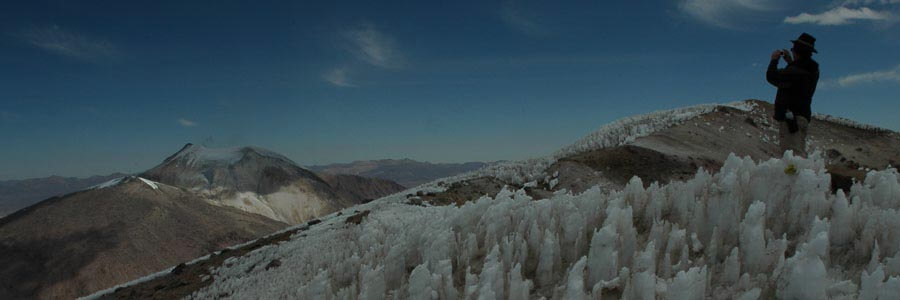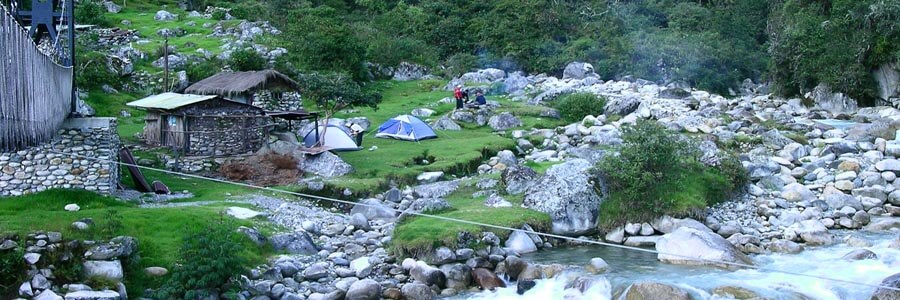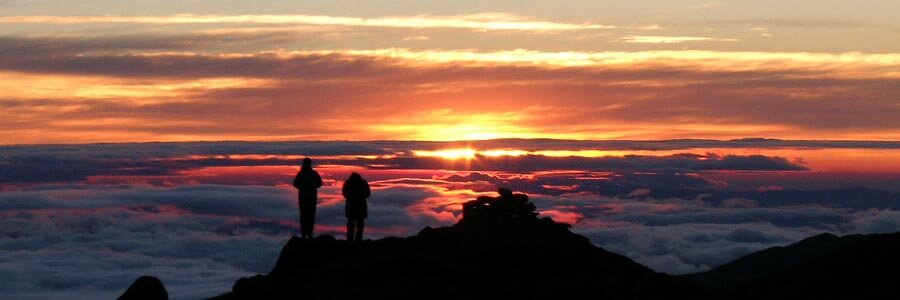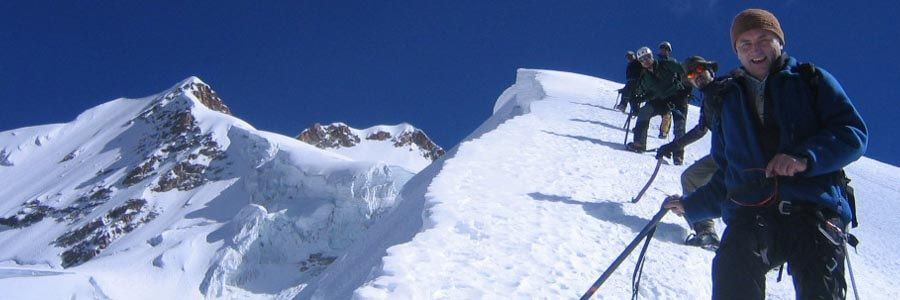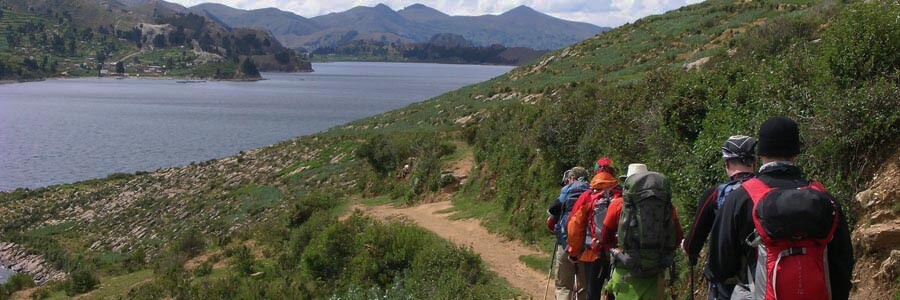Fauna and flora in Bolivia are as varied as the altitude of the different geographic zones, the complex topography, and the several climates found there.
According to preliminary inventories from the “Natural Resources Ministers”, there are: 1,.950 to 2,.500 tree species (10% of them provide wood), 1,200 species of moss, 1,500 species of ferns, 16 species of gymnosperm, and 11,000 species of angiosperm. The same inventory records: 322 species of mammals, 257 species of reptiles, 166 species of amphibious, and 550 species of fish. This inventory does not include insects.
Following, there is a list of some animals and plants in the highlands and mountains, and the Cloud Forest and Amazon Rainforest. We suggest you to check our Suggested reading page for more information about this subject.
Birds have been separated in a diferent page, Birds of the Andes.
Highlands and Mountains
Mammals
The most common camelids in the highlands are the Llamas; they can be seen in very steep mountain ledges up to 5,500m (18,040ft), mountain valleys, and plains. They are all domesticated and are used primarily: to carry packs, for their meat high in protein low in cholesterol, and for their wool. They are normally very quite, but they can spit, kick, or even bite when annoyed.
Smaller than the llamas, the Alpacas have also smaller faces, and have thicker and finer wool. These animals tend to live close to streams and grassy plains. They are also all domesticated and are used primarily for their wool.
The Antelope-like camelid; the Vicuña or Wari (Lama vicugna Fam. Camelidae) is smaller and has much shorter and finer wool than llamas and Alpacas. They are located in the Ulla Ulla reserve, Sajama National Park and further south at the Lipez deserts where they stay wild and are protected from hunting. Bigger than the llamas, Guanacos are also wild but very rarein Bolivia.
The agile and funny looking rodent; the Vizcachas (Lagidium viscacia Fam. Chinchilidae) looks like a rabbit, leaps like a kangaroo, and has squirrel-like tail. They live in colonies between large rocks near streams that flow down from glaciers. They can be normally seen at sunrise and sunset. They are close relatives of the Chinchillas that have been hunted to the extinction for their extremely fine fur.
The shy Andean Bear (bespectacled bears) is extremely rare and an endangered species. They live near the tree line at the couldforest. Unfortunately they are the target of many hunters who kill them for their meat and fat (that is supposed to cure many diseases), or farmers who hunt them because once in a while they attack cattle or destroy cornfields looking for food.
One of the main icons in Andean Mythology is the Puma. This animal is also very rare and an endangered species too. They are extremely difficult to be seen, since they hunt alone by night and are very quite. Local farmers also hunt this animal because they may attack llamas or sheep, or wild animals like Vizcachas and Deer.
The Andean Fox looks more like a Coyote, its fur is almost yellow and is smaller than European foxes. They usually hunt Guinea Pigs, mice and other small animals.
Armadillos are also endangered because people hunted them to make Charangos (small guitar-like instruments), or to stuff and sell them as souvenirs.
Other mammals like: Skunks’, Guinea Pigs, Mice, Rats, or Bats also live in the highlands. Mice have been seen at mountain high camps up to 5,200m (17,056ft).
Fish
Artificially introduced, Trout and Pejerrey (King Fish) are the most common fish in Titicaca Lake and smaller mountain lakes and rivers. Local fish like: Bogas, Karachi, Mauri, Umanto and Ispi are endangered because of over fishing and how aggressive trout and Pejerrey (King Fish) are.
Other animals
Titicaca lake also houses a wild type of Frog (telmatobius culeus). Provided with highly irrigated skin, these frogs breathe trough the skin the oxygen diluted in the water. Its strictly night and deep water habits make people to think they are blind.
Another strange inhabitant of Lake Titicaca is a type of sea horse.
Other animals as Snakes, Lizards, and lots of Insects (spiders, ants, butterflies, and scorpions) also live in the highlands and Andean valleys.
Plants
Although the Altiplano seems very arid and bleak in terms of vegetation, for a curious observer, there is much more population and variety than it appears. Vegetation is mainly composed by bushes, grass, and small trees, besides of the cultivated plants.
The main cultivated plants in the highland plains and hill ledges are: Potato, tuber with almost three hundred varieties, is the most common crop in the highlands, the high-protein Quinua grain (Chenopodium quinoa Fam. Chenopodiaceae, from the same family of the spinach) , different green beans like the Peas and Habas, white local beans like the Tarwi, Oats and other similar cereals. Down in the Andean valleys and riverbeds there are other crops like: Corn, or Wheat.
Among the many trees originally from the Andes is the Keñua (Polilepsis Tarapacana Fam. Rosceae), hard wood with red peeling bark, twisted branches and tiny leaves, is probably the toughest tree in the world, since they can live in extremely dry and cold environments. The highest population of Keñuas can be found in the Sajama National Park up to 5,200m (17,056ft).
Kishuara, a type of wild olive, also originally from the Andes, together with Keñua and bushes like Thola covered the highlands several years ago, making forests and providing shelter to animals and the early Andean inhabitants. Nowadays, agriculture and the use of firewood made most of these forests to be reduced to small-forested patches around villages, by riverbeds, and close to the mountains.
Eucalyptus, and Pine trees where introduced to the highlands from Australia and Unites Estates respectively.
Several cactus species can be found in the highlands, the most interesting ones grow farther south in the islands of the Salt Flats. In the island called Incahuasi (the Inca’s house) there is a giant named Jacha Quiru, literally huge stake (trichocerus psascana Fam.Cactaceae), as tall as 10,18m (33.39ft)
The most common wild vegetation in the highlands is the grass called Ichu, main food of the camelids, cows, and sheep. Wild Totora Reed grows on Titicaca Lake shores, which until some years ago, it was widely used to build reed boats (huge reed boats were used by the Norwegian explorer Thor Heyerdahl to cross the ocean). This Lake has also different kinds of algae on its bottom.
Probably one of the most extraordinary plant in the deserts is the Yareta also used for firewood (Azorella compacta Fam.Apiaceae).
Another jewel of the highlands is the giant pineapple-like Puya Raimundi, which is found only in Bolivia and the southern Peru.
Rainforest and Amazon basin
Mammals
Monkeys. These primates are probably one of the most attractive and funny inhabitants in the lowlands, showing great geographic variation in colour patterns. They are primarily arboreal, and descend to the ground only to cross an open space. A few species may forage in the ground when food is scarce in the trees. Some of the most interesting monkey kinds are: the tiny and shy Tamarins, the noisy haulers which sound can be heard 5km (3mi), or the incredibly agile Spider Monkeys.
Jaguars, Pumas, Tigers, and wild Dogs are very difficult to be seen because they are quite and lonely hunters. These carnivores (Fam. Carnivora) have a very wide diet. While some species are truly carnivorous or meat eating, others feed mainly on insects, fruits or even leaves. Other carnivorous also live in the lowlands like: coatis, skunks, and otters.
The Pink Dolphin or Boto, and the Gray Dolphin or Tucuxi (Fam. Cetacea) can be found in some muddy rivers or lagoons in the Amazon basin. Very little is known about these solitary animals, which are some of the most advanced groups of largely marine species that have large brains, good vision, acrobatic movements, and complex social behavior (it seems that they feel attracted by boats or people swimming near them).
Anteaters, Slots, and Armadillos (Fam. Xenarthra) belong to the same order of animals, they are so dissimilar externally that they hardly appear related. Most living members of this order are specialized feeders that eat mainly ants and termites or rainforest canopy.
Tapir is the largest terrestrial mammal in the territory; it belongs to the same order than Pigs and Rhinoceroses. They are herbivores, have large, rotund bodies, thick, muscular necks, and an elongated upper lip.
Manatees are very large, hairless, cigar-like shaped mammals, with forelimbs modified to flippers, no free hind limbs, and the rear of the body in the form of a horizontal paddle. These are entirely aquatic animals, and are very gentle herbivores that browse on aquatic vegetation.
Other mammals can also be found in the tropical forest, like: the wild pigs Jabali or Peccary, the elegant Deer, rodents like the agoutis or the Capybaras (the largest of the rodents), the agile Squirrel, and several kinds of Rabbits.
Fish
Fish species are widely found in rivers and lakes of the Amazon basin, they are one of the main food sources for jungle inhabitants. Some of them are: Pacu, Surubi, Palometa or Piraña.
Other animals
Mice and Rats are the most common mammals in the jungle. Their diet it is very varied, it may consist in: insects and other invertebrates, small vertebrates, seeds and fruit, and even fish.
Snakes, Lizards, Alligators, Turtles, Frogs, Butterfly, and lots of Insects (spiders, ants, butterflies, and scorpions) are also very relatively common in the tropical forest.
Bats as well are pretty common in the jungle side and have a wide diet, composed by: insects, small vertebrates, fruits, nectar, and blood. These are the only mammals that can fly, using a kind of sonar or echolocation to navigate and hunt, even in complete darkness. Bats are beneficial to humans; since they eat enormous quantities of insects, pollinate plants, and help regenerating the forest by dispersing seeds.
Plants
There are approximately 1,950 to 2,500 tree species in the lowlands, 10% of which produce wood. The most popular- and endangered - one is the Mahogany tree that has been cut down almost to the extinction in some areas of the country.
Agriculture in the lowlands is pretty developed in all the Andes, the main crops are: Cotton, Sugar Cane, Soya Beans, Coffee Beans, citric fruits like: Orange, Lime, Lemon, and Mandarin, some kind of tubers like: Walusa and Yucca, Coconut, Bananas, Mango Fruit, Coca Leaves, and much more. Palm Trees are also grown for their eatable heart.
Pacific coastline and south forests
Mammals
Blue Whale (Balaenoptera Musculus), Orcas (Orcinus Orca), Walrus (Mirounga Leocina), Sea lions (Leptonychotes Weddelli), "Lobo Marino" (Arctocephalus Gaxella) can be found furthersouth near to the Antarctic.
Slots, and Armadillos (Fam. Xenarthra) belong to the same order of animals, they are so dissimilar externally that they hardly appear related.
Llaca or Yaca (Thylamis Elegans) is one of the three marsupials in Chilean territory. This carnivorous has nocturnal habits and is quite simmilar to the common mouse.
Dear can also be found further south; the most common is the "Chilean Huemul" (Hippocamelus Bisulcus) that lives always below 1.300m (4.264ft) in steep and heavily forested terrain.
Fish
Chile has a big fishing industry thanks to the cold waters of the Humbold current which feed the Pacific coastline with nutrients. Jorel, Marluzas, Congrios, Lenguado and Corvina are the most common ones.
Other animals
Sell-fish ike: Machas, Ostion, Ostra, Loco, Almeja and Erizo are very common at the Pacific and probably the base of the diet among the local population.
Otter (Lutra Provocax and Lutra Felina) are among the animals in danger of extintion.
Plants
Near to the costline several types of palms grow: the "Palma Chilena" (Jubaea Chilensis) has the thickest trunk among the palms.
Further south Pine trees are among the most common and form huge forested areas. The "Alerce or Lahuén" (Fitroya Crupressoides) is one of the most commons. Its one of the slowast growing trees (increasing its diameter 1mm every three years) and one of the longeval (the oldest tree recorded has 3600 years) in the planet.
Other trees to be found in the central and south Chile are: Oaks (Nothofagus Oblicua), Olivillo (Aextoxicom Punctatum), Ulmo (Eucryphia Cordifolia), Pelu (Sophora Micriophylla), Rauli (Nothofagus Alpina) Tepa (Laurelia Phippiana) Avellano (Gavuina Avellana). Algae are very common at the coastline and several species can be found deppending of the deept


